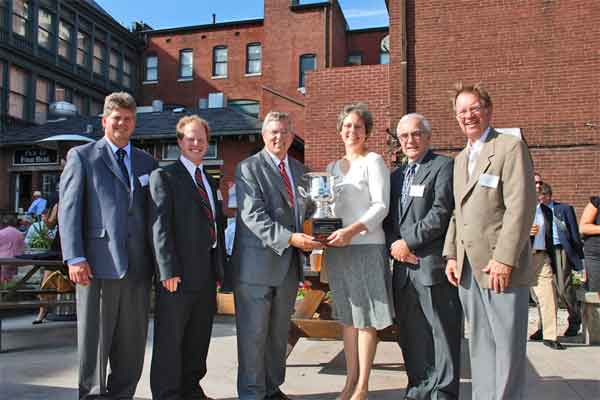Portland’s John Jay Center wins Statewide Restoration Award
Limberlost Contruction, General Contractor
September 17, 2008, Historic Landmarks Foundation presents THE COOK CUP
 |
Pictured L - R: Mike Schwartz, Trent Paxson, Rob
Weaver, Cindy Strietelmeier,
Doug Milligan and Barry Hudson. |
INDIANAPOLIS—The John Jay Center for Learning, Inc., won THE COOK CUP for
Outstanding Restoration of an Indiana Landmark on Saturday (September 13). The
award, a large engraved silver cup, was presented by Historic Landmarks
Foundation of Indiana in recognition of the center’s superb restoration of the
Weiler Building in downtown Portland.
Rob Weaver, the center’s executive director, accepted the award from Historic
Landmarks Foundation’s Chairman Jerry Fuhs at a preservation honors event at The
Athenaeum in Indianapolis. “The group took what many would have regarded as a
‘tear-down’ building and turned it into a state-of-the-art educational facility
and community center,” Fuhs declared.
As before-and-after images appeared on a large screen, Fuhs cataloged the Weiler
Building’s transformation from a vacant structure plagued with a bad roof,
broken windows, and water damage throughout. “Some walls were unstable, and
passers-by faced jeopardy from falling masonry. The interior was moldy, filled
with rodents, pigeon guano, debris, rotted wood and standing water. Pedestrians
noticed the smell,” he related. “Beyond this point, there be demons,” Fuhs
quoted George Ridgway, an architect on THE COOK CUP panel of judges.
“The restoration first cleaned and dried the place out and attended to the
failing structural elements and the exterior---the windows, doors, canopies, and
decorative terra cotta details. In Phase II, interior restoration respected the
significant features while adapting the building for its new use,” Fuhs said.
In a final touch, the John Jay Center recreated the long-gone historic pole
lamps that lined the roof until the 1940s, an elegant feature that the judges
likened to the icing on the cake. The judges were also impressed that the
project drew upon more than 300 contributors and many grant sources. In
determining the winner, the panel of judges also considered the positive
economic and aesthetic impact of the project on the community as a whole. Fuhs
asked all those associated with the John Jay Center project to stand and receive
applause for their accomplishment.
Historic Landmarks Foundation created the annual award last year as a “thank
you” to the Cook family for role in rescuing the West Baden Springs Hotel, a
National Historic Landmark, and their subsequent complete transformation of the
ruin. “It occurred to us that Historic Landmarks did not give an annual award
for restoration, so we created one and named it after these inspiring people.
Historic Landmarks hopes the great preservationists who receive this award for
decades to come will understand themselves as commended in the Cooks’ honor, and
be honored themselves to share in such company,” said Jerry Fuhs.
The inaugural COOK CUP for Outstanding Restoration of an Indiana Landmark went
to the to Bill, Gayle and Carl Cook in June 2007 at the grand opening gala
Historic Landmarks sponsored at the West Baden Springs Hotel in southern
Indiana. The Cook family was in Denmark for corporate meetings related to their
medical device business and asked Fuhs to let Weaver and the John Jay Center
supporters know that they’re very sorry they couldn’t be present to recognize an
organization that and made the Weiler Building a sparkling, useful jewel in the
community.
THE COOK CUP panel of judges included Jerry Fuhs, Historic Landmarks Vice
Chairman Michael Rodman and President Marsh Davis, Carl Cook, and George
Ridgway.
THE COOK CUP recognizes an owner who transformed a seriously dilapidated
landmark within the past two years, using the highest standards of restoration,
placed the structure in service, and positively impacted the immediate
neighborhood or community. The winner may be an individual, nonprofit
organization, corporation, or government and the structure may be restored for
its original use or adapted to a new purpose.